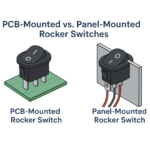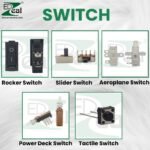PCB‑Mounted vs. Panel‑Mounted Rocker Switches: What’s the Real Difference?

PCB‑Mounted vs. Panel‑Mounted Rocker Switches: What’s the Real Difference?
If you’ve ever worked with electronics, you’ve likely come across rocker switches. They’re those little buttons you press to turn something ON or OFF—like on a power strip or your coffee machine. But did you know that not all rocker switches are the same?
In fact, how a rocker switch is mounted—whether it’s on a circuit board or on a front panel—makes a big difference in how it works and where it’s used. So, let’s break down the difference between PCB-mounted and panel-mounted rocker switches, in a way that’s easy to understand (no engineering degree needed!).
What Is a Rocker Switch, Really?
Let’s start with the basics. A rocker switch is a simple electrical component that rocks back and forth to open or close a circuit. Press one side, and your device turns ON. Press the other, and it switches OFF.
They’re used just about everywhere—from kitchen appliances and power tools to computers and vehicles. But depending on the design of the product, manufacturers use different types of rocker switches—and that’s where mounting styles come in.
PCB-Mounted Rocker Switches: Tiny but Mighty
What Are They?
PCB-mounted rocker switches are designed to be soldered directly onto a printed circuit board (PCB). If you’ve ever looked inside a remote, toy, or small gadget, you’ve seen one of these tiny green boards packed with components—rocker switches included.
Why Use Them?
These switches are great for compact devices where there’s limited space, and you want everything on one board. They’re usually installed during the assembly process in factories.
Where You’ll Find Them:
- Power adapters
- Small electronics
- Audio devices
- LED controllers
Pros:
- Take up very little space
- Great for small, enclosed gadgets
- Can be installed by machines—fast and efficient
- Clean layout with no extra wires
Cons:
- Not easy to replace
- Hidden from the outside—you can’t press them easily
- Mostly used inside the product, not meant for user access

Panel-Mounted Rocker Switches: The User-Friendly Ones
What Are They?
Panel-mounted rocker switches are the ones you can actually see and press. These are mounted on the outside panel of a device—think of that red switch on a power extension board or the ON/OFF switch on a kettle.
Why Use Them?
They’re perfect for any device where the user needs to interact with the switch regularly. You’ll often see them on dashboards, control panels, or machines where the operator needs easy access.
Where You’ll Find Them:
- Power strips
- Kitchen appliances
- Industrial control panels
- Car dashboards
Pros:
- Easy to press and replace
- Visible and accessible
- Often come with lights (like that little red glow when it’s ON)
- Can handle higher power
Cons:
- Need a cutout in the panel to mount
- Takes up more space
- Requires wiring—less compact than PCB versions
Quick Comparison: PCB vs. Panel Mount
| Feature | PCB-Mounted | Panel-Mounted |
|---|---|---|
| Installed on | Circuit board | Outer panel or casing |
| User access | No | Yes |
| Best for | Internal electronics | Devices users interact with |
| Wiring | Direct to PCB | External wires or terminals |
| Ease of replacement | Requires soldering | Easily swappable |
| Appearance | Hidden | Visible and often styled |
So… Which One Should You Use?
Here’s a simple way to decide:
- Building a compact, sealed device? Go for a PCB-mounted rocker switch. It’s neat, efficient, and works well when the user doesn’t need to touch it.
- Need the user to switch it ON or OFF easily? Go with a panel-mounted rocker switch. It’s visible, easy to press, and simple to replace later.
Think about the product, how it will be used, and who will be using it. That usually points you to the right choice.
Real-World Example
Let’s say you’re designing a table lamp.
If it has a touch sensor or remote control and no physical button, a PCB-mounted switch inside might be perfect. But if you want the user to flip the switch manually, then a panel-mounted rocker switch is the way to go.
Final Thoughts
Rocker switches may be small, but choosing the right type—PCB-mounted or panel-mounted—can make a big difference in how your device works and feels.
If you’re an engineer, maker, or DIY hobbyist, knowing the difference helps you design smarter, safer, and more user-friendly products. If you’re a buyer or business owner, it helps you get the right switch for your needs.
Need Rocker Switches in Bulk?
At DDS International Edzeal, we supply both PCB-mounted and panel-mounted rocker switches for every type of project—DIY kits, manufacturing, appliances, and more. We offer:
What to read next
-

By EDZEAL | October 11, 2025
Guide to Identifying Counterfeit Electronic Components in the Market
In today’s fast-moving electronics industry, counterfeit electronic components have become a major concern for manufacturers, OEMs, and engineers. These fake parts not only cause performance failures but can also lead to safety risks and financial losses. To ensure your circuits perform reliably and your products meet quality standards, it’s essential to know how to identify counterfeit electronic components before they enter your supply chain.
-

By EDZEAL | October 10, 2025
Everything You Need to Know About Switches in Electronics
Switches are one of the most important parts of electronics. From simple household items like lights and fans to big machines in factories, switches help us control electricity easily and safely. Every time you press a button, flip a switch, or turn a knob, you are using a switch to control how electricity flows. In this blog, we’ll understand what switches are, how they work, the different types of switches, and where they are used — all in simple words.
-

By EDZEAL | September 29, 2025
Resistor Color Code Guide: 3-Band, 4-Band, 5-Band & 6-Band Explained
Resistors are one of the most common electronic components, and identifying their values correctly is essential in circuit design, testing, and repair. Since most resistors don’t have printed values, engineers rely on the resistor color code system to determine resistance. In this guide, we’ll cover 3-band, 4-band, 5-band, and 6-band resistor color codes, provide a resistor color code chart, and explain how to read values such as 1k, 10k, 100k, 220 ohm, 470 ohm, and more.
